
A white Russian is a cocktail made with vodka, coffee liqueur and cream served with ice in an old fashioned glass.
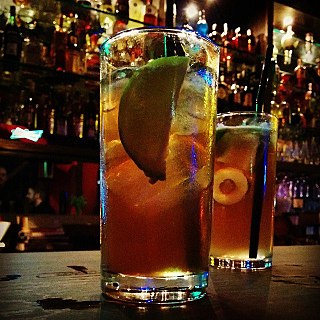
The Long Island iced tea, or Long Island ice tea, is an IBA official cocktail, typically made with vodka, tequila, light rum, triple sec, gin, and a splash of cola. Despite its name, the cocktail does not typically contain iced tea, but is named for having the same amber hue as iced tea.
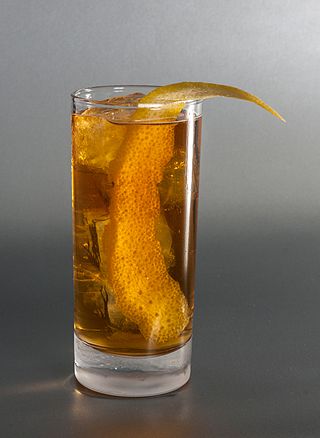
A horse's neck is an American cocktail recognised by the International Bartenders Association (IBA), identifiably sporting a long, curling strip of lemon rind.
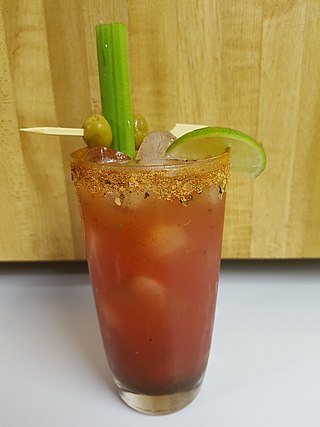
A Caesar is a cocktail created and consumed primarily in Canada. It typically contains vodka, Clamato, hot sauce, and Worcestershire sauce, and is served with ice in a large, celery salt-rimmed glass, typically garnished with a stalk of celery and wedge of lime. What distinguishes it from a Bloody Mary is the inclusion of clam broth. The cocktail may also be contrasted with the Michelada, which has similar flavouring ingredients but uses beer instead of vodka. Festivals dedicated to the cocktail are held in many cities, with the largest in Calgary. The first liquor store dedicated to the Caesar opened on July 1 2023 in Calgary, Alberta.

Eggnog, historically also known as a milk punch or an egg milk punch when alcoholic beverages are added, is a rich, chilled, sweetened, dairy-based beverage. It is traditionally made with milk, cream, sugar, egg yolks, and whipped egg whites. A distilled spirit such as brandy, rum, whiskey or bourbon is often a key ingredient.

Vodka Red Bull is a caffeinated alcoholic drink consisting of the energy drink Red Bull and varying amounts of vodka. Although some people consider it a cocktail, it fails to meet this definition under the International Bartending Association's criteria.
"Hair of the dog", short for "hair of the dog that bit you", is a colloquial expression in the English language predominantly used to refer to alcohol that is consumed as a hangover remedy. Many other languages have their own phrase to describe the same concept. The idea may have some basis in science in the difference between ethanol and methanol metabolism.

Advocaat or advocatenborrel is a traditional Dutch alcoholic beverage made from eggs, sugar, and brandy. The rich and creamy drink has a smooth, custard-like consistency. The typical alcohol content is generally between 14% and 20% ABV. Its contents may be a blend of egg yolks, aromatic spirits, sugar or honey, brandy, vanilla, and sometimes cream. Notable makers of advocaat include Warninks, Bols, Darna Ovo Liker, DeKuyper, and Verpoorten.
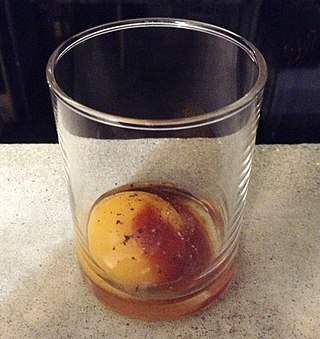
A prairie oyster is a traditional beverage consisting of a raw egg, Worcestershire sauce, vinegar and/or hot sauce, table salt, and ground black pepper. A small amount of tomato juice is sometimes added, reminiscent of a Bloody Mary. Occasionally a spirit such as brandy, vodka, or gin is also included, transforming the drink into a hair of the dog. The egg is broken into a glass so as not to break the yolk. The mixture is quickly swallowed. The unbroken yolk causes the drink to bear a texture similar to that of an oyster. The concoction has been referred to as a traditional cure for hangovers, and has appeared in media for decades.

Various unique terminology is used in bartending.
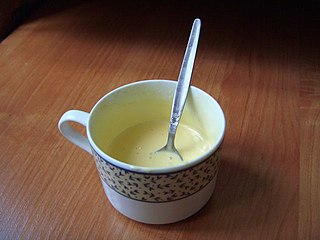
Kogel mogel is an egg-based homemade dessert once popular in parts of Europe. It is made from egg yolks, sugar, and flavourings such as honey, vanilla, cocoa or rum, similar to eggnog or zabaione. In its classic form it is served slightly chilled or at room temperature. Served warm or hot, it is considered a home remedy for sore throats. Variations include milk, honey and soda.

A flaming drink is a cocktail or other mixed drink that contains flammable, high-proof alcohol, which is ignited before consumption. The alcohol may be an integral part of the drink, or it may be floated as a thin layer across the top of the drink. The flames are mostly for dramatic flair. However, in combination with certain ingredients, the flavor of the drink is altered. Some flavors are enhanced, and the process may impart a toasted flavor to some drinks.
Ready to drink packaged beverages are those sold in a prepared form, ready for consumption. Examples include iced tea and alcopops.
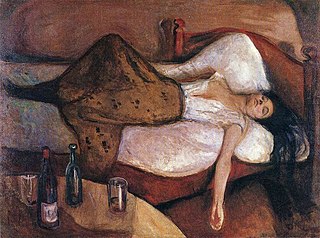
A hangover is the experience of various unpleasant physiological and psychological effects usually following the consumption of alcohol, such as wine, beer, and liquor. Hangovers can last for several hours or for more than 24 hours. Typical symptoms of a hangover may include headache, drowsiness, concentration problems, dry mouth, dizziness, fatigue, gastrointestinal distress, absence of hunger, light sensitivity, depression, sweating, hyper-excitability, irritability, and anxiety.

A Bloody Mary is a cocktail containing vodka, tomato juice, and other spices and flavorings including Worcestershire sauce, hot sauces, garlic, herbs, horseradish, celery, olives, pickled vegetables, salt, black pepper, lemon juice, lime juice and celery salt. Some versions of the drink, such as the "surf 'n turf" Bloody Mary, include shrimp and bacon as garnishes. In the United States, it is usually consumed in the morning or early afternoon, and is popular as a hangover cure.

Rocky Mountain cuisine is a cuisine of Alberta and British Columbia in Canada; Idaho, Colorado, Wyoming, Utah and Montana in the United States. Some distinguishing dishes include bison and Rocky Mountain oysters, or prairie oysters as they are known in Canada.

Hangover remedies consist of foods, dishes, and medicines, that have been described as having a theoretical potential for easing or alleviating symptoms associated with the hangover.















